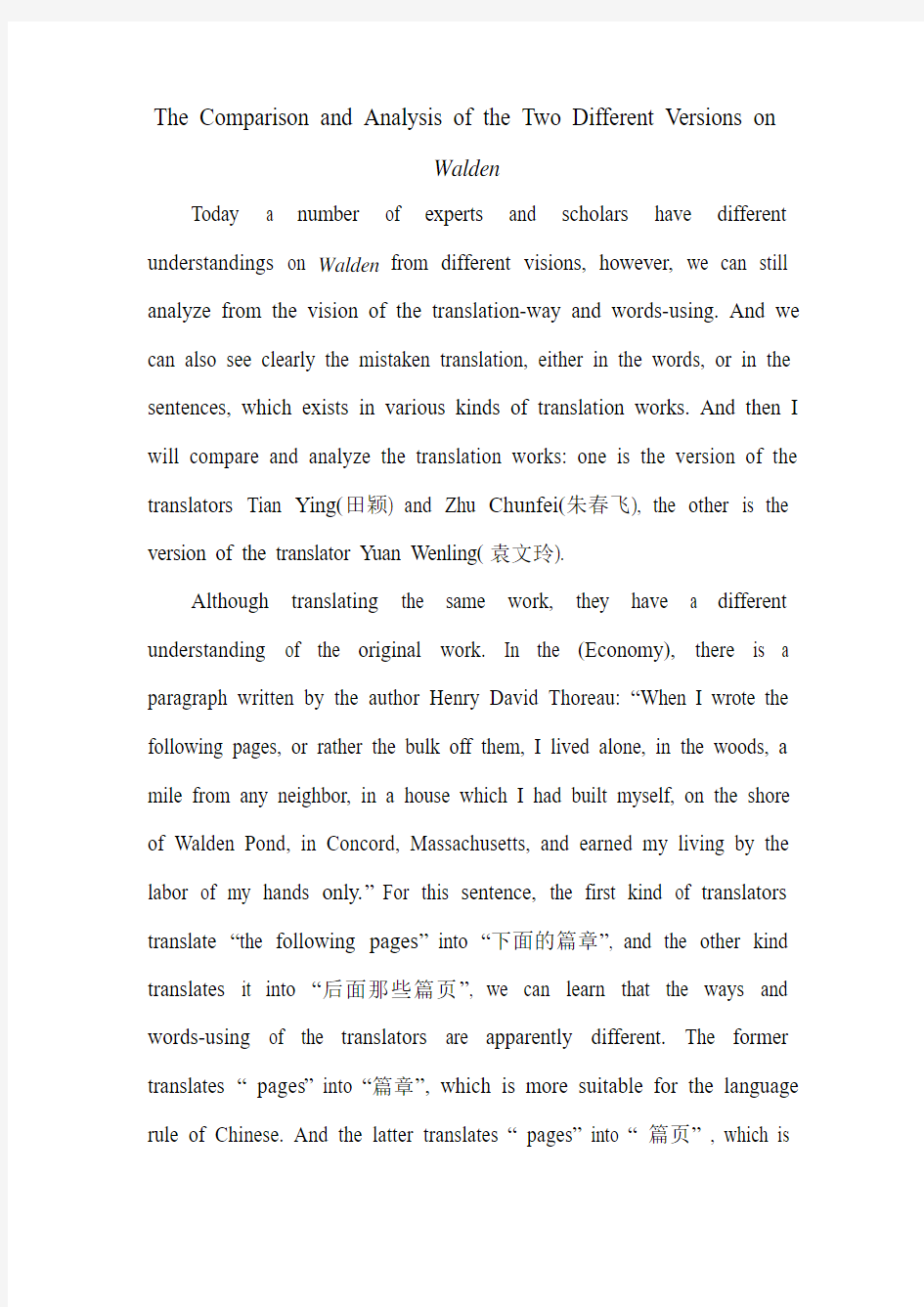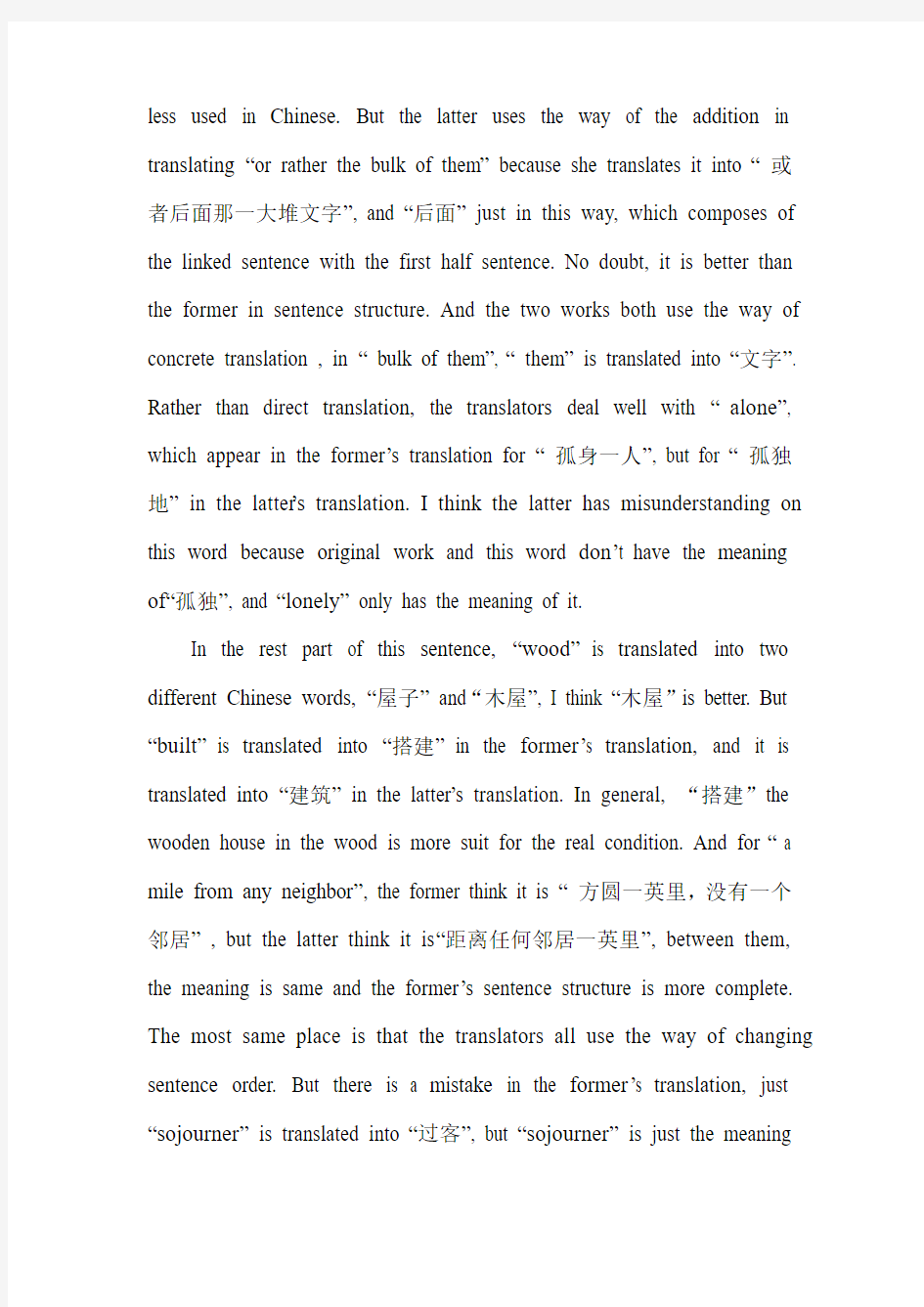The Comparison and Analysis of the Two Different Versions on Walden


The Comparison and Analysis of the Two Different Versions on
Walden
Today a number of experts and scholars have different understandings on Walden from different visions, however, we can still analyze from the vision of the translation-way and words-using. And we can also see clearly the mistaken translation, either in the words, or in the sentences, which exists in various kinds of translation works. And then I will compare and analyze the translation works: one is the version of the translators Tian Ying(田颖) and Zhu Chunfei(朱春飞), the other is the version of the translator Yuan Wenling(袁文玲).
Although translating the same work, they have a different understanding of the original work. In the (Economy), there is a paragraph written by the author Henry David Thoreau: “When I wrote the following pages, or rather the bulk off them, I lived alone, in the woods, a mile from any neighbor, in a house which I had built myself, on the shore of Walden Pond, in Concord, Massachusetts, and earned my living by the labor of my hands only.”For this sentence, the first kind of translators translate “the following pages”into “下面的篇章”, and the other kind translates it into “后面那些篇页”, we can learn that the ways and words-using of the translators are apparently different. The former translates “ pages” into “篇章”, which is more suitable for the language rule of Chinese. And the latter translates “ pages” into “篇页” , which is
less used in Chinese. But the latter uses the way of the addition in translating “or rather the bulk of them” because she translates it into “或者后面那一大堆文字”, and “后面” just in this way, which composes of the linked sentence with the first half sentence. No doubt, it is better than the former in sentence structure. And the two works both use the way of concrete translation , in “ bulk of them”, “ them” is translated into “文字”. Rather than direct translation, the translators deal well with “alone”, which appear in the former’s translation for “孤身一人”, but for “孤独地” in the latter’s translation. I think the latter has misunderstanding on this word because original work and this word don’t have the meaning of“孤独”, and “lonely” only has the meaning of it.
In the rest part of this sentence, “wood”is translated into two different Chinese words, “屋子” and“木屋”, I think “木屋”is better. But “built”is translated into “搭建”in the former’s translation, and it is translated into “建筑” in the latter’s translation. In general, “搭建”the wooden house in the wood is more suit for the real condition. And for “ a mile from any neighbor”, the former think it is “方圆一英里,没有一个邻居” , but the latter think it is “距离任何邻居一英里”, between them, the meaning is same and the former’s sentence structure is more complete. The most same place is that the translators all use the way of changing sentence order. But there is a mistake in the former’s translation, just “sojourner” is translated into “过客”, but “sojourner” is just the meaning
of “逗留者”, so “旅居者” in the former’s translation is more exact.
In another paragraph, the former regard “ anticipate” as the meaning of “观看”, while the latter translate it into “观赏”, the latter is better. But this sentence “It was of the last importance only to be present at it.” is translated into the absolute different meanings: “出现在日出之时,才最有意义” and “在日出之前出现是最重要的事了”. We can find that the sentence order is not same and the time is different between the former’s sentences and the latter’s sentence. It is clear that “only to be present at it” is translated into two different versions: “出现在日出之时” and “在日出之前出现”, which are different meanings between the former and latter. In fact , “出现在日出之时” is more accurate while “在日出之前出现” is not very appropriate.
In the two paragraphs, we can know that Tian Ying’s translation is more excellent than Yuan Wenling in using words and sentence structure. And Tian’s translations follow more our Chinese habits of language, while Yuan’s translations more obey to the style of the original work. And there are some mistaken understandings about the original work in the latter translation. To our surprises, they all use the different or same ways in this paragraph, such as, the way of changing forms, the way of concrete, the way of combining sentence, the way of changing sentence order, the way of omission, the way of addition, the way of cutting sentence and way of direction. Whatever style the translators’ translations
belong to, most importantly, the translation must follow three kinds of rules: faithfulness, expressiveness, elegance. And the former is more next to the rules.
